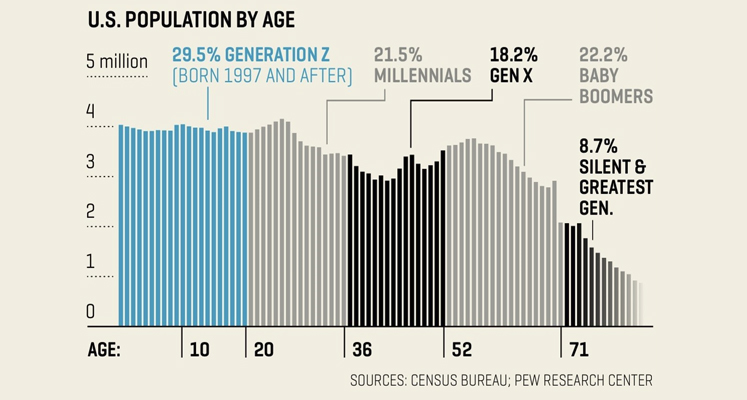source: TTI Market Eye article
As Baby Boomers make way for Millennials in the high-tech workforce, a new generation gap is yawning. The population reared in the digital age is engaging with colleagues whose golden rule is face-to-face communication. The current electronics market will test the skills of both generations.
The electronics supply chain hasn’t faced a severe components shortage in more than a decade. In the interim, the people and processes in procurement have drastically changed. E-commerce has finally hit its stride and Millennials have joined the ranks of component buyers. But with many components currently in short supply, expertise in digital communications isn’t necessarily seen as an asset.
“Millennials operate a little different than the historical way where it was more of a face-to-face relationship-building atmosphere,” said a distributor executive. “I think when it comes to crunch time, there will be some scrambling because there are some things you can’t do by clicking a button on a computer.”
“Crunch time” is here. IP&E component suppliers AVX, Kemet, Murata and Vishay are quoting lead times out to the first quarter of 2018 for many of their products. DRAM is expected to be in short supply through the first half of 2018. Inventories at the industry’s two largest distributors – Arrow Electronics Inc. and Avnet Inc. — were described as “lean” in one recent market update. The Institute for Supply Management’s August report on business found shortages of capacitors, integrated circuits and memory.

Get in line
Customers join a hierarchy when components are scarce: big and strategic customers move to the head of the line. For everyone else, a good relationship with a supplier or distributor counts for a lot.
Supply chain managers acknowledge relationships take a lot of work. “We have heard with some of our power supply engineers and field sales reps that it has been challenging over the past six to eight months — in some cases — to get appointments with customers,” said one distributor executive. Other distributors and manufacturers reps share that experience.
An extended period of adequate supply and the ease of e-commerce has reduced the need for person-to-person communication in the electronics supply chain. But some industry veterans believe Millennials are ill-equipped to deal with a prolonged component shortage.
“You got a bunch of 30-year old [supply chain] advocates and people at big companies — at the GEs, Schneiders and Siemens — that have never seen a market where they didn’t have extreme buying power,” said one supplier executive. “They beat suppliers up; and one of the reasons why is a profitability problem and because suppliers will do anything to maintain their business. These 30-year-old kids who think they can demand anything and haven’t focused on relationships and only focused on their power, when lead times go out, they will find out how hard and ugly a market can be.”

Speaking “Millennial”
However, businesses acknowledge Millennials are the workforce of the future. Electronics companies are accepting the notion that business communications and relationship-building must change.
“It’s starting to move from people talking about Millennials as if they were an alien invasion to recognizing they are ‘us,’” said Michael Knight, senior vice president, Americas, for distributor TTI Inc. “However, their ideas about communication – text, e-mail or online forums — are very different than what we grew up with.”
At the ERA Executive Conference 2017, a panel of engineers discussed how they prefer to seek help. “They said ‘I don’t want to talk to anybody but in a pinch, I’ll talk to whoever gets to me the fastest,’” Knight said. “They prefer text messaging or e-mail. They don’t want these contacts to be intrusive and they prefer to talk to someone that works for a component manufacturer. We need to pay attention to that.”
There’s no foregone conclusion that only one method will be the way customer relationships are managed, Knight said.
“Regardless of the age of our customers — this might mean someone younger adapting to how an older customer wishes to communicate — we must always adapt to how they want to engage. After all, they are the customer,” said Carla Mahrt, president of electronics industry executive recruiting firm JJM Search. “I also think the more often veterans of the industry interface with the younger generation, as long as they keep an open mind, the more they will determine there are more commonalities than differences.”
One of those commonalities is instant gratification. “I think due to the fast pace of the world today, where answers are right at your fingertips on the internet, we have all grown impatient waiting for answers,” said Mahrt. “One of the key questions I ask new clients and hiring managers is what their preferred method of communication is – phone, e-mail, texts etc. The answer varies by the hiring manager and isn’t always due to their age. Several Millennials I have spoken with said that rarely have they worked with someone that is so inept at digital communication that it became a problem.”
Strained Relationships
In fact, the industry has begun to turn away from “Millennial bashing” and associations are educating their members on how to attract younger talent. Managers have shared positive experiences in hiring Millennials. The generation gap alone is not straining supply chain relationships.
“I think the whole nature of [supplier-customer] relationships have changed,” TTI’s Knight said. “The whole business has gotten progressively more mercenary. But I don’t want to say relationships don’t matter anymore because they do, they just don’t seem to matter as much as they once did.”
Customers can be fickle, even when it comes to contractual obligations. Buyers continually price shop — it’s their job to get the best value for their company – and play vendors against one another for the lowest price. Some may book business outside of contractual arrangements. But when components are scarce, contracts are viewed as a guarantee of supply. For many vendors, that leads to a difficult conversation with their customers.
“Many common, widely used parts are hard to come by right now, so there is a rebirth of customer interest in the relationship aspect of their supply chain,” Knight said. “But the timing is bad. What we are all up against on constrained parts is suppliers start allocating them to distributors and distributors start allocating them to their customers. What is typical is that you are allocated a quantity of parts equivalent to some prior year’s consumption [orders] to prevent companies from hedging and overbuying. That’s the cause of the historical cliff the component supply chain has gone over on the backside of these cycles. This doesn’t leave a lot of room for new, or even renewed, relationships.”
“It’s not just interpersonal relationships that aren’t what they once were,” Knight concludes. “We have all become conditioned to a more transactional, mercenary approach to our supply chain engagements. This is in part due to the business pace and globalization, in part due to generational differences, and in part due to technology changing the way we interact with each other. It is what it is and for the most part works fine… until a production line goes down, or a production target goes up, and you are told it will be six months or more before you can get the parts you need.”
This article appeared in Electronics Purchasing Strategies, www.epsnews.com September 28, 2017 by Michael Knight

































